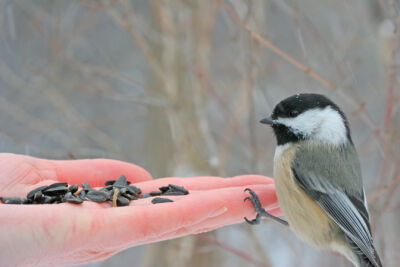A Familiar Winter Bird: Black-capped Chickadee
Likely, it is the distinct song of the black-capped chickadee that makes it so identifiable. The most familiar call is the cheery “chick-a-dee-dee-dee”, which reputedly gave this talkative, little bird its name. While, to the human ear, the notes may sound simple, they are highly variable and astonishingly complex.
A Chickadee Song
Produced by both the male and female, their call is used for communicating information about food sources, coordinating flock movement, and identifying and recognizing other flocks. It is also an alarm call alerting others to predators and threats. A recent study showed that the more “dee” notes in a “chick-a-dee” call, the greater the threat from nearby predators. For instance, a dangerous raptor may generate four or five extra “dees” instead of the typical two.
Another recognizable song, particularly during mating season, is the two note “fee bee” call. Some hear it as “cheese-bur-ger” or “you-who”. Males often use it to defend their territory or attract a mate.
During winter, these inquisitive, sociable birds travel in small flocks and are often accompanied by an assortment of other small birds, such as nuthatches, titmice, creepers, kinglets, and woodpeckers. Those associated with chickadee flocks respond to chickadee alarm calls, even when their own species does not have a similar warning system.
Preparing for Winter
Chickadees are permanent residents of Ontario and do not migrate south for the winter. This requires them to be adaptable when searching for food. As opportunistic feeder, their diet varies with each season depending on what is available.
In summer, chickadees devour numerous spiders, caterpillars, and other insects, particularly when a high protein diet is necessary to feed their growing young. As voracious insectivores, these birds provide an important form of natural pest control. Their diet changes as the weather cools. In the fall and winter, the bulk of their food is composed of wildflower seeds, berries, and hidden, dormant insects.
As avid seed-eaters, they regularly visit backyard feeders, making them one of the first birds people learn to identify. Due to their curious personality, they have a habit of investigating everything in their home territory, including humans. They are friendly by nature and many who are accustomed to humans readily accept sunflower seeds from an out-stretched hand.
Chickadees are food-caching birds. When food is plentiful, they store seeds and other food items which they retrieve later. They hide morsels of food singly in several different locations including bark crevices, dead leaves, knotholes, and clusters of conifer needles. Each item is placed in a different spot and chickadees can remember thousands of hiding places.

Photo by Brenda Gallagher
To keep track of their food, they have developed excellent spatial memories. Chickadees relocate scattered caches using visual cues, such as surrounding features and objects. To adapt to changes in their environment and to help remember cache locations, chickadees are also able to replace old neurons in their brain with new ones, allowing them to create space for additional information as they age. As well, studies show that chickadees fed a diet high in spiders when young were bolder and learn more quickly as adults. Although harder to find and less filling than caterpillars, spiders contain very high levels of tourine, an amino acid essential in developing visual acuity and overall brain function.
Chickadees that live in harsher environments frequently have limited access to available food, thus their cognitive abilities to recover food locations is more important for winter survival. These northern birds have been found to have enhanced spatial memories, a larger hippocampus and more neurons than those that live in milder climates, where food is easier to find and reliance on memory is not as imperative.
Home and Habitat
Black-capped chickadees nest in cavities in dead standing trees or rotting logs. Together, the male and female excavate the soft, decaying wood of existing natural cavities, or refurbish abandoned woodpecker holes. Only females sit on the eggs and the male often brings her food during this incubation period. Once the nestlings hatch, both the male and female act as caregivers, providing their young with foraged insects.
So the next time you see these fun, little birds, you can admire them for both their beauty and intelligence.
Contact: Brenda Gallagher, Forestry Technician

